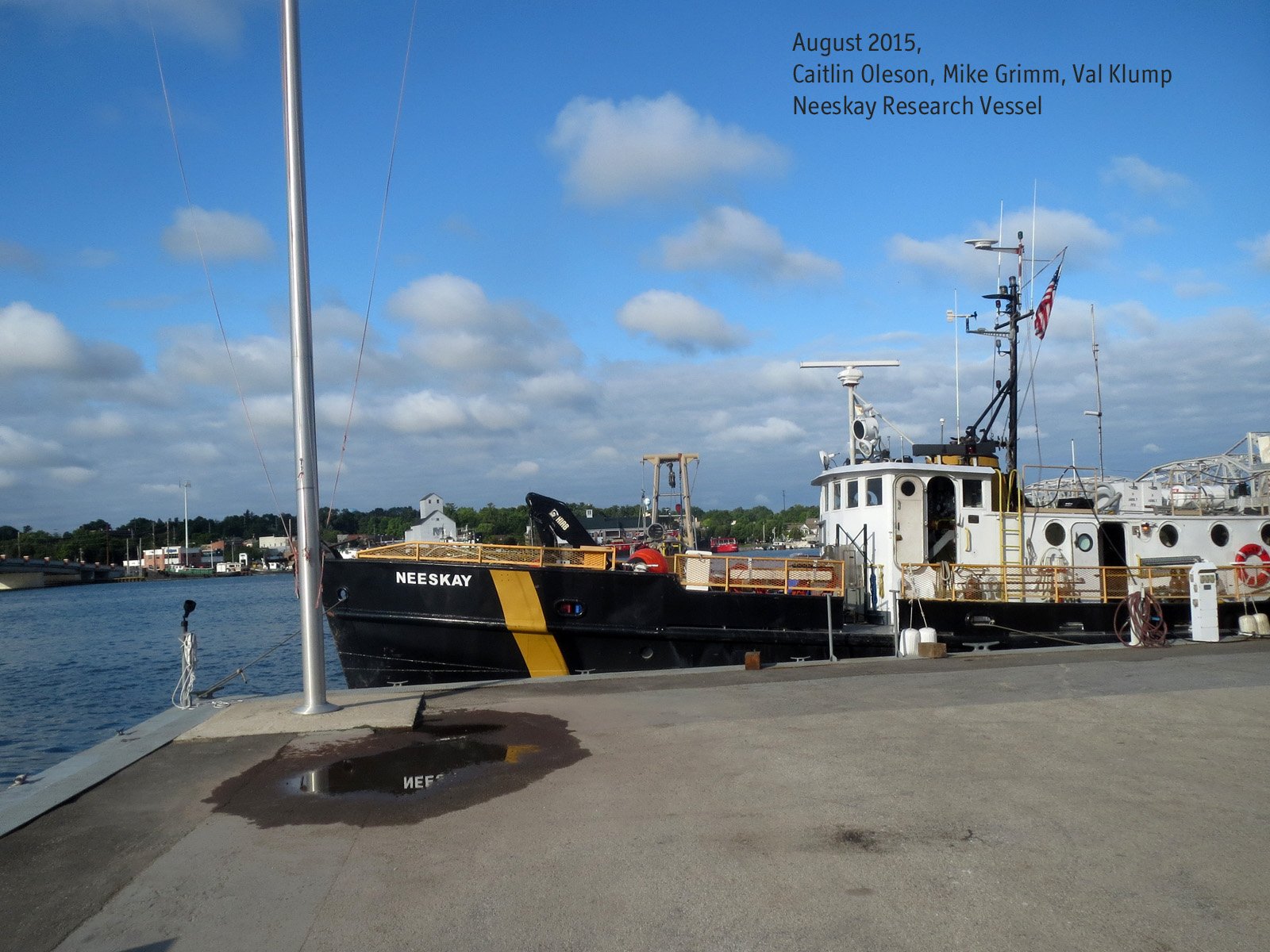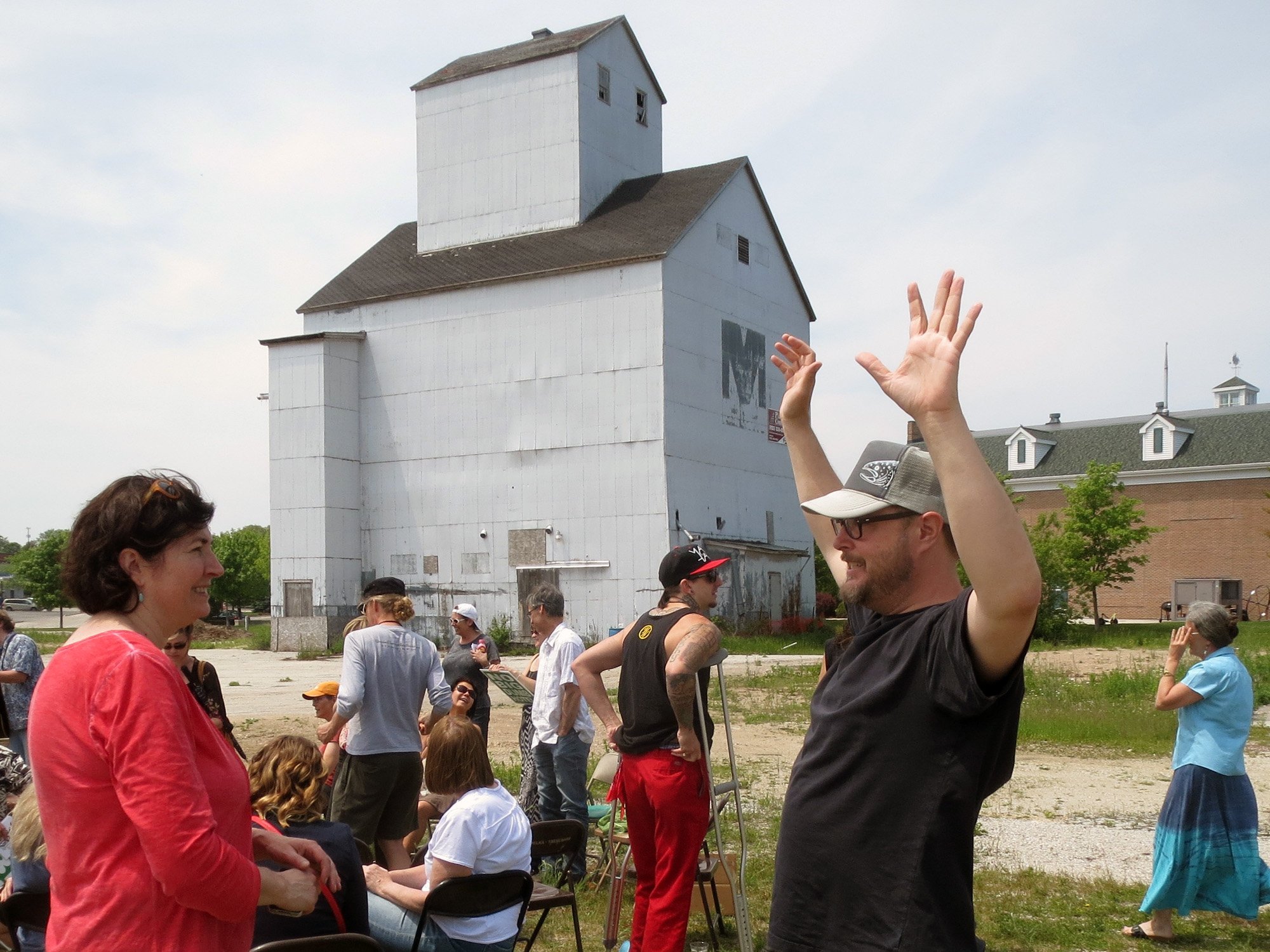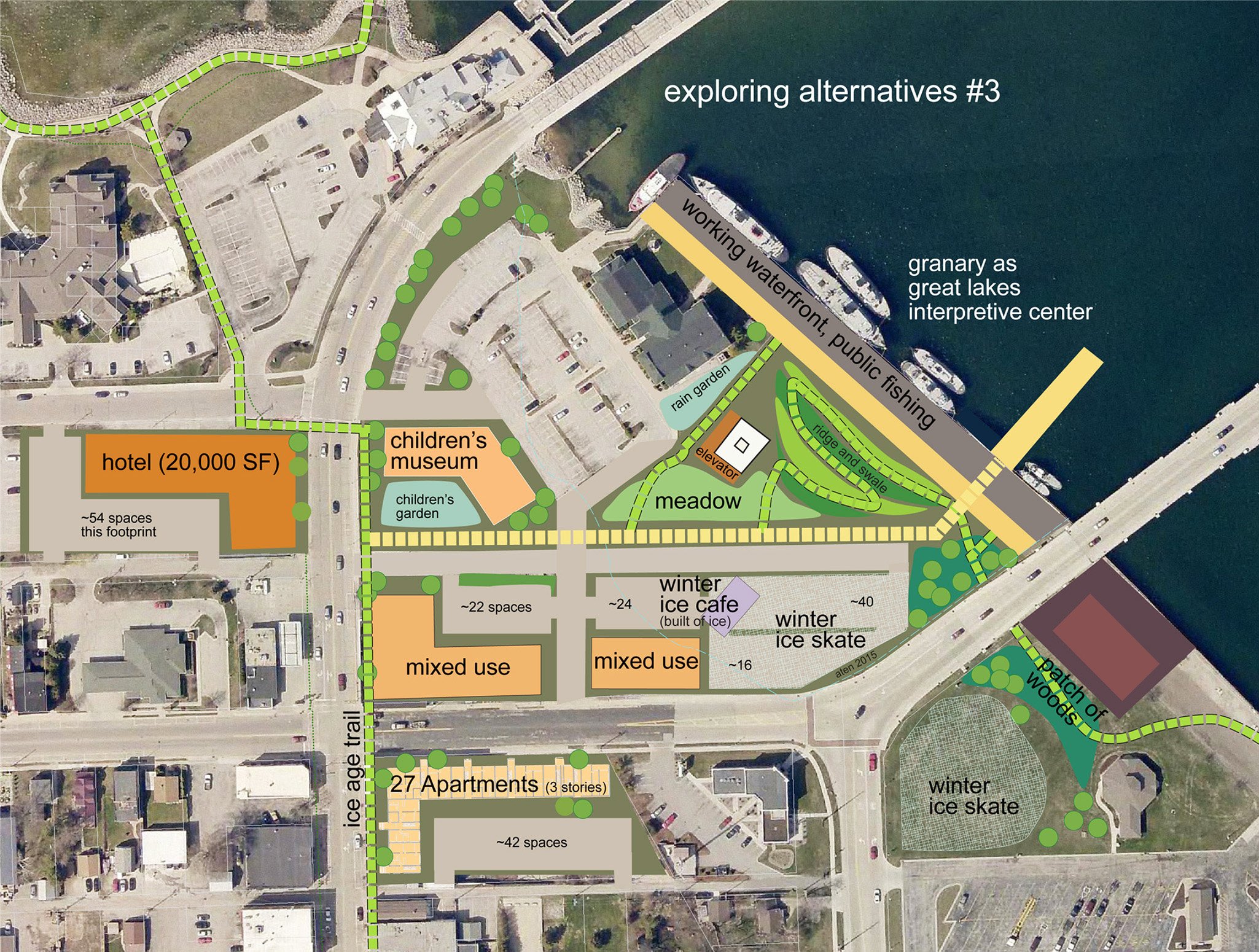Friends of Sturgeon Bay Public Waterfront
This visioning work accompanies the archive page that documents the successful six-year effort 2014-2020 (plus any ongoing related concerns) by ordinary citizens to protect the Public Trust Doctrine in Sturgeon Bay, WI. Return to main archive.
In parallel with the community’s outreach and eventually legal effort to protect the public waterfront from private commercialization, we launched several projects to work toward a thriving public waterfront benefiting the community.
Key dates:
August 2015: Meeting aboard the research vessel Neeskay in Sturgeon Bay for initial brainstorming
January 2016: Kickoff Conference at UW-Green Bay hosted by Matt Dornbush, led by Caitlin Oleson and attended by 25 professionals from the UW system, state agencies, and community members.
February 2016: Patrick Robinson’s talk on the Lake Superior National Estuarine Research Reserve process and facilities, at UW-Green Bay
March 2016: Field trip and visit with staff at Lake Superior NERR
2016-2017: A year’s research into facilities needs and case studies by Caitlin under the direction of UW-Green Bay
1 February 2016
Re: Formation of the Lake Michigan Research Institute
I am writing today to indicate strong support for the formative steps needed to create a Lake Michigan Research Institute. This Institute could serve as a public-private partnership to facilitate and support Lake Michigan basin research initiatives that are currently ongoing and those foreseen as needed in the future. Several universities, state agencies, federal agencies and regional non-profits have communicated the desire to make Lake Michigan basin research more effective, efficient and productive. Sturgeon Bay is perfectly located to provide convenient access to ideal marine (as well as terrestrial) research sites representing broad environmental gradients and factors. The Lake Michigan Research Institute could provide a platform for thoughtful expansion of work needed to preserve, protect and enhance Lake Michigan as an ecological, recreational and economic asset, and have wide-reaching implications well beyond our region.
The initial focus of such an entity would be to i) provide basic onshore, dockside and laboratory support for Lake Michigan research vessels and activities, ii) coordinate or provide year-round basic housing for researchers, faculty, students, interns and professionals on a daily, weekly, monthly or seasonal basis and iii) facilitate community outreach and engagement for K-12 students, interested community members, local business and the environmental research technology industry. The opportunities to engage our local students and provide meaningful career connections to marine research is a personally very exciting aspect.
Caitlin Oleson conceived this Institute beginning with a meeting aboard the research vessel Neeskay in Sturgeon Bay in August 2015. Her work to bring the project to this point is impressive, and her ongoing leadership will certainly be key to its success. I look forward to the formation of a Board of Directors for the Lake Michigan Research Institute that will formalize this role and provide support.
It is with great pleasure that I enthusiastically support the formation of this venture by way of this letter along with a pledge of support.
Nancy Aten
See detailed Notes from January 2016 Lake Michigan Research Institute Conference
Lake Michigan Research Institute
This early effort has led to the current, ongoing process to establish a Lake Michigan National Estuarine Research Reserve for the Green Bay estuary.
In July 2015, in response to the City of Sturgeon Bay’s RFP (Request for Proposals), a proposal has been submitted for development on the West Waterfront that envisions a public and private partnership to repurpose the Teweles and Brandeis Granary making it once more an economic and iconic center of Sturgeon Bay. Under the proposal, the repurposed Granary would be a magnet for vibrant community activity (entrepreneurial and recreational) and create a new “Granary District” or “Granary Neighborhood” in Sturgeon Bay’s west side.
See full proposal here.
Community members then offered brainstorming ideas to enrich the project development, including support for needed community meeting spaces, and a maritime freshwater research outpost.
Repurposed Granary
The 1901 Teweles & Brandeis granary built on a large dock at the waterfront had been featured as an iconic and important historic structure in City planning documents for the waterfront. To demonstrate public possibilities, members of Friends developed a proposal for a repurposed granary (see below); organized a community group, the Granary Collective, to discuss historic preservation; led to the launch of the Sturgeon Bay Historical Society; successfully achieved National and State Registry for the granary; and the current restoration of the granary for public use with a lakebed lease from the State of Wisconsin.
Center Line Community Forum
Established in March 2015, with this mission statement:
Center Line offers the Sturgeon Bay and greater Door County community access to local, regional and national speakers on topics designed to strengthen community, encourage civic engagement and formulate vision for smart growth. The series focuses on inviting the best thinkers of today to share creative ideas that have been successfully implemented across the country. It celebrates the preservation of our unique identity and our history while exploring ways to proactively embrace the challenges and opportunities of the future. It is meant to spark ideas and generate discussion.
Center Line first sponsored a trip in April 2015 to tour Eau Claire, WI’s award-winning Phoenix Park and downtown waterfront redevelopment. Center Line’s mission is to strengthen community, encourage civic engagement and explore ways in which smart growth has been successfully implemented in other communities.
Center Line also offered a community suggestion box, with 87 submitted ideas for the public waterfront and a vibrant community between 2015 and 2019.
A few of these were implemented, like Bird City Wisconsin designation for Sturgeon Bay.
Public Waterfront
(Eventually, in 2018-2019, thanks to newly elected Council members, the City established an Ad hoc Westside Waterfront Planning committee, with a mission to take a fresh look at the future of the westside waterfront, to bring a design/development plan forward to the community for input and eventually to the City Council for ratification – to be making forward progress in preparation for the day when the Public Trust Doctrine Ordinary High Water Mark defining public waterfront is resolved. Both things happened.)
January 2017
These detailed compromise options had been developed by Friends of the Sturgeon Bay Public Waterfront over time leading up to January 2017.
[As the City and opponents to the public waterfront continually evolved their arguments as each argument was defeated, the “need for parking” was a focus at this time, hence addressing that directly in options.]
The current site offers 208 parking spaces total (see last image).
“A” is the win-win option that Friends made very public in January 2017. Its advantages: minimal disturbance to DCMM parking; all is surface parking to minimize $; gives sites for three potential new developments. It offers 240 paved parking plus 32 additional parking or grass parking = 272.
“B”, not made public, incorporated a parking garage ramp on site. This is the same footprint, almost, as on the east side. This envisions the parking garage ramp would have a partial ground floor (with partial retail), full first floor, and partial rooftop (with partial viewing space or hotel amenity). This plan includes a driving access through the site between the bridges. With the parking garage it is 376 parking spaces, plus possible temporary or grass parking of 62 spaces = 438.
“C”, not made public, incorporates a parking garage ramp off-site, in the future, if that site within the TID became available. Without that, it is 214 spaces plus the potential for 128 in front of the hotel as grass-pave to reduce visual impact = 342. With the parking garage ramp, it is 444, and if you add the 128 grass-pave spaces that’s 572.
“Grass-pave” event or temporary parking could just be on lawn, or could be a structural underlayment that supports more regular vehicular traffic along with growing grass.
Public / park space should, of course, be designed through an open community process.
Spring 2015
Here are West Waterfront Alternate Site Ideas based on suggestions heard from community members at public meetings in Spring 2015.
The spirit of brainstorming is creative thinking, unrestrained and spontaneous participation, and freewheeling group discussions. Public meetings have provided many creative ideas from and for the community.
This set of five alternative drawings contain elements that came directly from community member ideas expressed in the Westside Waterfront "super-committee" meetings of Spring 2015 (these drafted by N. Aten).
Note that #3 envisioned the granary as a Great Lakes Interpretive Center (see Lake Michigan Research Institute, above).
The above activities are just some of what community members worked on and contributed, through many avenues, and endeavors of all scales, in support of a vibrant public waterfront and City in this place we love. Thank you.

























